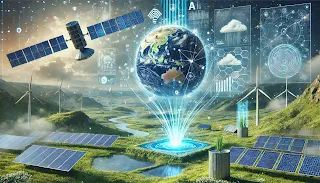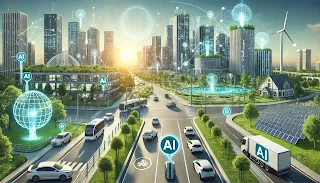What Is AI's Role in Climate Change?
- Get link
- X
- Other Apps
What Is AI's Role in Climate Change?
Artificial intelligence influences climate change in two contrasting ways:
Environmental Costs
- Energy Consumption: Training AI models requires massive computation
- Infrastructure Demands: Data centers, cooling systems, and hardware manufacturing c
Sustainability Solutions
- Optimized Resource Use: AI optimizes energy grids, improves agricultural practices, and enhances industrial efficiency.
- Environmental Monitoring: Advanced AI systems track deforestation, monitor air quality, and assess ecosystem changes.
 |
| AI Solutions for Climate Change |
The Environmental Cost of AI
1. Energy Consumption
AI models require intensive computing resources, leading to high energy use and significant carbon emiss
2. Growing Computational Demands
As AI evolves, its computational needs grow exponentially. This increase
AI as a Solution for Sustainability
1. Climate Modeling and Prediction
AI-driven models analyze vast environmental datasets, enabling:
- More accurate predictions of extreme weather events
- Improved understanding of climate systems
- Enhanced risk assessment for natural disasters
2. Energy Optimization
AI optimizes energy systems through:
- Smart grid management
- Integration of renewable energy sources
- Efficient resource allocation for power grids
3. Environmental Monitoring
AI technologies analyze satellite images, track biodiversity, and monitor ocean health. This allows scientists to respo
Applications of AI in Sustainability
1. Sustainable Agriculture
AI s
- Enhancing crop yields through precision farming
- Optimizing water usage
- Monitoring soil health
2. Smart Cities and Urban Planning
AI contributes to sustainable urban development with:
- Traffic flow optimization
- Waste management syste
- Energy-efficient building designs
3. Industrial Efficiency
AI helps industries achieve sustainability goals by:
- Reducing waste through process optimization
- Enhancing supply chain efficiency
- Monitoring resource consumption
 |
| Sustainable Applications of AI |
Challenges and Ethical Considerations
1. Technical Challenges
AI developers must address:
- High energy demands of AI systems
- Limited availability of su
2. Ethical Concerns
Equity, transparency, and access to AI-powered solutions remain significant issues. Ensuring fairness in AI applications and addressing env
Future Directions
Green AI Development
Efforts to create "green AI" focus on:
- Developing ene
- Leveraging renewable energy for AI operat
- Designing sustainable computing infrastructures
Policy Recommendations
Governments
- Implement energy efficiency standards for AI systems
- Encourage carbon-aware computing practices
- Invest in research on AI sustainability
Conclusion
Artificial intelligence holds immense poten
References
- Brown, T. B., Mann, B., Ryder, N., et al. (2020). Language models are few-shot learners. arXiv preprint arXiv:2005.14
- Strubell, E., Ganesh, A., & McCallum, A. (2019). Energy and policy considerations for deep learning in NLP. arXiv preprint arXiv:1906.02243.
- Rolnick, D., Donti, P. L., Kaack, L. H., et al. (2019). Tackling climate change with machine learning. arXiv preprint arXiv:1906.05433.
- Henderson, P., Hu, J., Romoff, J., et al. (2020). Towards the systematic reporting of the energy and carbon footprints of machine learning. Journal of Machine Learning Research, 21(248), 1-43.
- Schwartz, R., Dodge, J., Smith, N. A., & Etzioni, O. (2020). Green AI. Communications of the ACM,
- Get link
- X
- Other Apps




Comments
Post a Comment